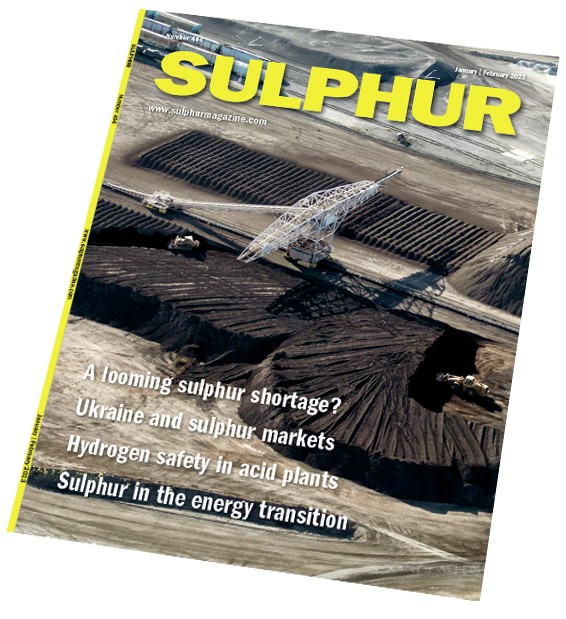Sulphur 404 Jan-Feb 2023

31 January 2023
Burning sulphur to lower temperatures

“But it is also to combat the effects of atmospheric sulphur dioxide on the environment… that sulphur is currently removed from fossil fuel”
It has long been known that sulphur dioxide aerosols can reflect sunlight back into space. On a large scale, this has tended to come from volcanic eruptions. The explosion of the island of Krakatoa in 1815 led to the following year, 1816, becoming known in Europe as ‘the year without a summer’. More recently, it is estimated that the eruption of Mount Pinatubo in the Philippines in 1991, the second largest eruption of the 20th century, sent around 18 million tonnes of SO2 into the stratosphere. Temperatures in the troposphere – the atmospheric layer closest to the earth – dropped by about 0.5°C as a result for about two years afterwards.
As concerns about the effects of man-made climate change increase, it has been suggested that this could be a way of temporarily reducing global temperatures to buy more time for a switchover to a lower carbon economy – so-called geoengineering. The most recent edition of the UN’s Montreal Protocol report includes a chapter on stratospheric aerosol injection, and in the US, the Biden White House Office of Science and Technology Policy began a five-year research plan last October to study ways of modifying the amount of sunlight that reaches the Earth in order to temporarily temper the effects of global warming.
But while the topic has gained scientific respectability as the effects of climate change become more pronounced, it also has plenty of detractors. The most common aerosol suggested is the one known to work via volcanic eruptions – sulphur dioxide. But it is also to combat the effects of atmospheric sulphur dioxide on the environment (via acid rain), and on human health, that sulphur is currently removed from fossil fuels. While the idea is to release the SO2 at high levels, where it can have maximum cooling effect, and it is hoped that little makes its way back down to sea level to cause the kind of problems we saw in the 1970s and 80s, how much of it will do so is still poorly understood. Likewise the impact of SO2 on warming the stratosphere is still uncertain. While it cooled climate at sea level, the Pinatubo eruption is believed to have warmed the upper atmosphere by 3.5°C, and potentially caused disruption to high level atmospheric air currents like the Jet Stream.
That being the case, a small US start-up company called Make Sunsets has also made waves in the past few weeks by saying that it has already begun releasing SO2 into the stratosphere via weather balloon flights, and it is selling what it describes as $10 ‘cooling credits’ to fund larger scale releases. It claims that every gramme of sulphur released as high level SO2 counteracts the effect of one tonne of CO2 – a somewhat contentious claim, as CO2 emitted today can stay in the atmosphere for 100 years, while the effects of the SO2 only last for 1 or 2 years. Still, Make Sunsets – the name comes from the increased redness of dusks and dawns that would be caused by upper atmosphere particulates – argues that sulphur geoengineering is not a panacea, but a ‘less worse’ option than enduring a global temperature rise of 1°C or more over the next few decades.
For the moment, the releases are very small scale, and more for publicity and research purposes than any serious attempt to change the climate. A cynic might suggest that Make Sunsets is more of a green-tinged cash grab than a true attempt to save the planet, and there is widespread opposition to the idea of geoengineering on a for-profit basis, and calls for a global framework to prevent such tinkering without global agreement.
But here at Sulphur I couldn’t help wondering what the impact might be were scientific consensus move to decide that releasing high level SO2 was indeed the way forward. An annual release on the scale of the Pinatubo eruption – 18 million t/a of SO2 – equates to 9 million t/a of sulphur. That is a lot, but not outside the bounds of possibility were we to have to start supplying it. And Make Sunsets claims that to achieve 0.5°C of cooling only a targeted 1 million t/a of SO2 would be required, or 500,000 t/a of sulphur – less than a large scale gas project or a couple of major refineries and well within the reach of the industry. The science is very much up for grabs at the moment, but if it were true, it might be a very cheap way of reducing global temperatures.






